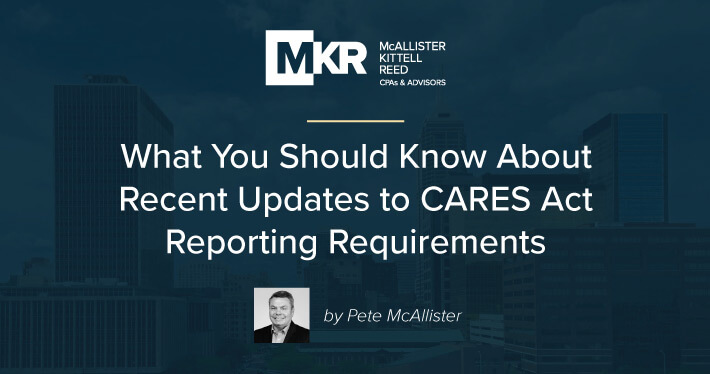
by Stephen Reed | Accounting News, Construction, COVID-19, Industry - Construction, News, Tax Planning
Last year construction contractors saw projects suspended indefinitely (or scrapped altogether) and escalated competition in the bidding process, both of which effectively stifled profit margins. It’s safe to say that the construction industry was not spared the upheaval of 2020. After such a tumultuous year, tax planning for 2021 might seem like a daunting challenge, but it’s a critical step for construction contractors in preparation of the year ahead.
Essential Tax Provisions for 2021 Preparation
With the uncertainty of the Covid-19 pandemic and a transfer of administrations in the White House this year, new legislation affecting tax provisions is a possibility, but there are several provisions under the current tax law, including those put in place under the Coronavirus Aid, Relief, and Economic Security (CARES) Act, that you want to be sure not to pass over.
Bonus Depreciation
Are you eligible to use the bonus depreciation this year? Changes have been made to qualifying property under both the Tax Cuts and Jobs Act (TCJA) and the CARES Act as follows:
- TCJA: expanded the bonus depreciation deduction to 100% for specified property obtained and placed in service after Sept. 27, 2017, and before Jan. 1, 2023.
- CARES Act: authorized the qualified improvement property (QIP)—typically interior improvements to nonresidential property—to be depreciable over 15 years and eligible for 100% bonus depreciation.
Tax Credits and Deductions
These tax credits and deductions could aid in reducing tax liability for contractors:
- Research and development credits: contractors who test new techniques or processes on construction jobs could be eligible.
- Deduction for energy-efficient government buildings: contractors may be eligible for a deduction of up to $1.80 per square foot for building energy-efficient commercial buildings intended for federal, state or local governments.
- Credit for energy-efficient residential properties: Contractors can take advantage of tax credits for certain energy-efficient residential properties.
Note that the deduction and credit for energy-efficient buildings expire at the end of 2021.
Qualified Business Income Deduction
The TCJA replaced the 9% “domestic production activities deduction” under IRC Section 199 with a 20% Qualified Business Income deduction under IRC Section 199A. It also increased eligibility to encompass more businesses. Contractors might want to start the conversation with their tax advisor on how to maximize this deduction as well as receive guidance on how to maneuver through the calculation’s somewhat complicated rules and limits.
Flexibility with Accounting Methods
Smaller construction firms (meaning those with average gross receipts of less than $26 million from the prior three years) generally enjoy more flexibility with tax accounting methods. Such firms could be eligible to use cash, accrual, completed contract or “accrual less retainage” accounting methods, all of which usually aid in managing the timing of revenue recognition. This allows companies to stimulate revenue to counterbalance current losses and recognize revenue now in expectation of higher future tax rates.
Additional Tax Planning Considerations Amid the Pandemic
To help minimize the risks of ongoing economic uncertainty, contractors should consider keeping apprised of tax changes. Given the seemingly ever-changing legislation amid the pandemic, construction firms should keep in regular contact with their tax advisors in order to avoid any tax reform surprises. However, contractors should also aim to operate without presumption of further legislation. While the economic effects of the pandemic are ongoing, don’t assume further stimulus legislation like the Paycheck Protection Program will be passed by Congress.
In light of a turbulent 2020, the construction industry has experienced a return to the business practices that have proven successful in the past: more attention to jobsite monitoring, legal contracts, and insurance costs. Contractors can contact an MKR advisor to incorporate 2021 tax planning into this process.

by Pete McAllister | Accounting News, CARES Act, COVID-19, News, Relief Bill, Stimulus, Stimulus Package, Tax
President Trump recently signed a second stimulus package—called the Consolidated Appropriations Act, 2021 (Act)—into law. The legislation includes over $300 billion in aid for small businesses. Below is a breakdown of some of the business tax changes and extenders in the new COVID-19 relief bill.
Payroll Tax Credit for Paid Sick and Family Leave
The refundable payroll tax credit for paid and sick family leave, established in the Families First Coronavirus Response Act, is extended until March 31, 2021. The tax credits are modified so that they now apply to practically any payments made to workers for these purposes.
Payroll Tax Repayment
The time frame for employees to repay deferred employment taxes under the President’s executive order, which was issued in August 2020, has been extended from April 2021 to December 31, 2021.
Employee Retention Credit
The Employee Retention Credit (ERC) under the CARES Act has extended to July 1, 2021. Further, the refundable tax credit has increased from 50% to 70%, the per-employee wages limitation has increased from $10,000 per year to $10,000 per quarter, and the determination of a large employer for purposes of the ERC has increased from 100 to 500 employees.
30-Year Depreciation of Certain Residential Rental Property
The new law determines that the recovery period relevant to residential rental property placed in service before Jan. 1, 2018, and held by an electing real property trade or business, is 30 years.
Business Meal Deduction
Rather than the current 50% business expense deduction for meals, the bill temporarily allows a 100% expense deduction for meals provided by restaurants in 2021 and 2022.
Deduction for Energy Efficient Commercial Buildings
The deduction for energy-efficient improvements to commercial buildings, such as lighting, heating, cooling, ventilation, and hot water systems was made permanent. The amount will be inflation-adjusted after 2020.
Changes to the Work Opportunity Tax Credit
If employers hire workers who are members of one of more of ten targeted groups under the Work Opportunity Tax Credit (WOTC) program, they are permitted to use an elective general business tax credit. Previously applicable to hires before 1/1/2021, the TCDTR extends the credit through 2025.
Employer Payments of Student Loans
Section 127, which permits employers to provide certain educational assistance to employees on a tax-free basis, was modified under the CARES Act to authorize the payment by an employer of principal or interest on specific employee qualified education loans through December 31, 2020. The Consolidated Appropriations Act expands this through December 30, 2025. As the pandemic subsides, employers may want to consider this valuable tax-free benefit.
Health and Dependent Care Flexible Spending Arrangements
The bill allows taxpayers to roll over unused funds in their health and dependent care flexible spending accounts from 2020 to 2021 and from 2021 to 2022. This arrangement also permits employers to grant employees a 2021 midyear prospective adjustment in contribution amounts.

by Pete McAllister | Accounting News, CARES Act, COVID-19, Healthcare, Industry - Healthcare, News, Tax Consulting
The Coronavirus Aid, Relief, and Economic Security (CARES) Act Provider Relief Fund was initially established to provide funding to healthcare service providers impacted by the COVID-19 pandemic. While the financial support has provided much-needed relief, the programs introduced some additional rules and reporting requirements for healthcare providers. On October 22, 2020, the Department of Health and Human Services (HHS) updated its guidance on how providers should report their Provider Relief Fund (PRF) payments that have been allocated for expenses and lost revenues as a result of the pandemic. Below is an overview of what you need to know.
Key Clarifications to Instructions
Addressing some of the ambiguity present in the previous September 19 update, two key clarifications were set forth.
- Method of accounting: The HHS has clarified that PRF payments should be reported using the provider’s normal method of accounting (cash or accrual basis).
- Lost revenue definition: In a twist from prior instructions, which defined lost revenue as a negative change in year-over-year net patient care operating income, recipients may now apply PRF payments up to the amount of the differences between their 2019 and 2020 actual patient care revenue.
If recipients do not use PRF funds in full by the end of the 2020 calendar year, they will have a further six-month period in which to utilize leftover amounts for expenses attributable to the pandemic but not repaid by other sources, or to apply toward lost revenues in an amount not greater than the difference between 2019 and 2021 actual revenue.
PRF Reporting Requirements
The deadlines from here on out are as follows:
- January 21, 2021: HHS portal opens for PRF reporting
- February 15, 2021: Reporting deadline for all providers on use of funds, assuming all proceeds were accounted for in 2020
- July 31, 2021: Final reporting deadline for providers who did not fully spend PRF funds before December 31, 2020
- September 30, 2021: Due date for the single audit or program-specific audit reports for a December 31 year-end or the earlier of 60 days from the date of the issuance of the audit report
PRF recipients can start submitting PRF reports documenting how funds were spent or attributed beginning January 15, 2021. The level of reporting requirements differs by the amount received as follows:
- Entities that received less than $10,000 in total from the PRF do not have to file a report
- Entities that received more than $10,000 but less than $500,000 must submit a simplified report with only these broad expense categories: general administrative expenses and other healthcare-related expenses.
- Entities that received more than $500,000 in PRF must submit a detailed report described below.
- Entities that received over $750,000 in PRF may also be subject to an audit per federal regulations.
Audit Requirements
If an entity received more than $750,000 in PRF, they may be subject to an audit per federal regulations. Audits are required for entities (non-profit and commercial as it relates to PRF per HHS guidelines) that spent over $750,000 from federal grant funds in a reporting period. Note the difference between receiving $750,000 and spending $750,000. Some funds could have been received in cash but not yet spent.
Let MKR CPAs & Advisors help
Our trusted advisors are equipped with the expertise to help you unravel the complexities of these reporting requirements. If you need assistance, contact an MKR advisor today to get the conversation started.

by Jean Miller | Accounting News, Bookkeeping, Business Consulting, COVID-19, News, Resources, Tax
Congress passed the Paycheck Protection Program Flexibility Act (PPPFA) on June 5, 2020, amending several provisions in the original PPP loan program. Along with granting business owners more flexibility and time to spend the PPP loan proceeds, the Act permits funds to be used on a wider-ranging variety of expenses while still allowing for loan forgiveness. Here is how this will affect businesses moving forward with a PPP loan.
Extended Covered Period
Originally, borrowers had 8 weeks from the receipt of loan proceeds to spend funds on forgivable expenditures. Now the covered period specifies 24 weeks after the origination of the loan, or December 31, 2020, whichever is sooner. To qualify for forgiveness, however, borrowers must maintain payroll levels for the full 24-week period. Borrowers do have the option to stick with the 8-week deadline, and they must likewise maintain payroll levels through the full 8 weeks to qualify for the full loan forgiveness amount.
Additional extensions include the timeline for eliminating reductions in workforce and wages, as well as restoring workforce levels and wages to pre-pandemic levels required for loan forgiveness (both extended to December 31, 2020).
Changes to Percentage of Payroll Costs
The PPPFA reduced the payroll expense requirement from 75% to 60%, which means that 40% of the PPP loan funds may now be put towards forgivable non-payroll expenses such as mortgage interest, rent, and utilities. Note that the expenses originally designated as forgivable have not changed.
Changes to Repayment Period
For borrowers whose loans are not forgiven, the PPPFA increases the repayment timeline from two years to five years. The 1% interest rate remains the same.
Changes to Rehiring Requirements
The PPPFA also extends the rehire date to December 31, 2020 and allows for a reduced headcount. Rather than basing loan forgiveness on a borrower’s ability to rehire the same number of employees on payroll as was used to calculate the loan, the PPPFA allows for loan forgiveness amount to be determined by documentation showing that the borrower was (1) not able to rehire former employees and unable to hire similarly qualified employees, or (2) not able to return to pre-pandemic levels of business activity in response to federal guidelines related to COVID-19.
Changes to Payroll Tax Deferment
The CARES Act originally prevented borrowers who received PPP loan funding from deferring additional payroll tax once the lender decided to forgive the loan, but the PPPFA eliminates this restriction, and borrowers can now defer the payroll tax for the period from March 27 to December 31, 2020.
Overall, the PPPFA will ease the burdens of businesses that received PPP loans, but it doesn’t fix everything or answer all the questions, so expect more regulations and changes to the PPP program in the near future.

by Jean Miller | Accounting News, News, Retirement, Tax, Tax Planning - Individual
According to a 2017 study from Career Builder, nearly 78% percent of people live paycheck to paycheck, with little to no money left over after financial obligations are paid. This means that nearly 8 out of 10 workers may not be able to handle even a $500 emergency. Here’s how to break the paycheck-to-paycheck cycle.
Build a Budget
Yes, this tired old budget thing is rearing its head again, but every financial plan needs to start here. You simply must know where your money is going. Start by creating a simple spreadsheet in Google Docs, which can be shared if you have dual contributors to your household income. If you’re ready for something a bit more sophisticated, Mint.com is a great online tool for budgeting. It will even send you notices and alerts, creating a more personal budgeting experience.
In order to know where your money is going, you need to also track your spending. Document every single purchase for two to four weeks. You’ll be surprised at how seemingly insignificant purchases can quickly add up. Typically, this exercise helps consumers to be more mindful of how they’re spending.
Establish and Emergency Fund
If you approach saving by promising to set aside whatever’s leftover after your financial obligations are paid, you’ll never make a dent in creating an emergency fund, let alone heftier savings goals. Funds intended for saving should come before any other spending. Aim to initially save the equivalent of one month’s paycheck.
Quick fix: put saving on autopilot. If your company offers a 401(k) plan, make sure you’re participating in it. You can also set up an automatic transfer on paydays to have some money automatically transferred from your checking account into a savings account.
Pay Down Debt
Nothing perpetuates the paycheck-to-paycheck cycle like having debt looming over your head. Control and monitor your spending by discontinuing the use of credit cards until you’ve paid them off. To streamline this process, you can consolidate your debt by transferring all your credit onto one card. While you’re focused on paying off debt, avoid taking out any kind of loan. If you can chip away at your debt while simultaneously building up an emergency fund, you can use that fund to pay for any unexpected expenses that may crop up instead of relying on credit cards.
Examine Your Lifestyle
Sometimes fixing the paycheck-to-paycheck cycle is as simple as taking a hard look at your lifestyle and making adjustments where necessary. Is your monthly car payment too high? Does your monthly mortgage payment exceed 28% of your monthly gross income? Are you paying for subscriptions or memberships you don’t use? You get the idea. Examine your monthly costs and find ways to scale back.
Stop Treating Raises and Bonuses as Fun Money
If you’re stuck in the paycheck-to-paycheck cycle, upticks in earnings such as raises, bonuses, and tax returns should be stashed away in savings, not spent on wants and splurges. Likewise, you shouldn’t rely on bonuses as part of your budget. These earnings should be used to increase your emergency savings or retirement funds.
If you have questions or would like to talk about how the information in this article may impact you personally, please reach out to me at [email protected] and we’ll schedule a time to talk.





